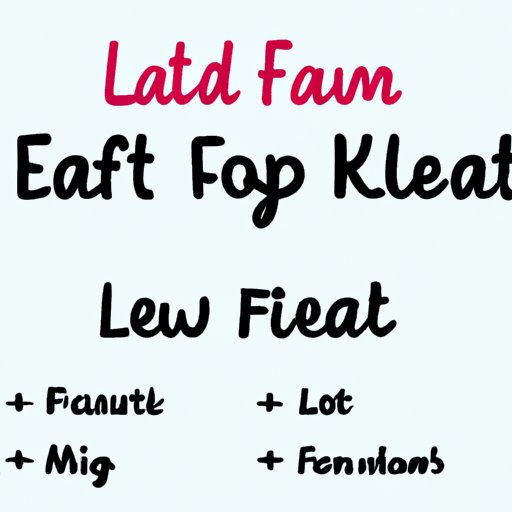Introduction
A low fat diet is one that limits the intake of saturated and trans fats, which are typically found in animal products and processed foods. The goal of a low fat diet is to reduce the risk of heart disease, diabetes, and other chronic conditions by decreasing the amount of unhealthy fats in one’s diet. While some fats are necessary for good health, it is important to understand the types of fats, the recommended daily allowance, and how to incorporate healthier fats into your diet.

Exploring the Role of Fats in a Healthy Diet
Fats are an essential part of a healthy diet, providing energy and helping the body absorb vitamins and minerals. There are four main types of fats: saturated, polyunsaturated, monounsaturated, and trans. Saturated fats are found primarily in animal products such as meat and dairy, while polyunsaturated and monounsaturated fats are found in plant-based sources such as nuts, seeds, and avocados. Trans fats, or partially hydrogenated oils, are created through a chemical process and found in many processed foods.
The American Heart Association recommends limiting saturated fat intake to less than 7% of total calories per day and avoiding trans fats altogether. For example, if you consume 2,000 calories per day, no more than 140 calories should come from saturated fat. Eating a variety of foods from all food groups is the best way to ensure adequate nutrition without consuming too much fat.
In addition to limiting unhealthy fats, it is important to include healthy fats in your diet. According to Registered Dietitian Nutritionist, Samara Felesky-Hunt, “Healthy fats like olive oil, avocado and fatty fish are an important part of a balanced diet. Not only do they provide essential nutrients and help us absorb fat-soluble vitamins, but they also provide satiety and keep us full longer.”

Meal Ideas for Low Fat Diets
When following a low fat diet, it is important to focus on nutrient-dense whole foods such as fruits and vegetables, lean proteins, and healthy fats. Here are some meal ideas to get you started:
Breakfast Ideas
Oatmeal with fresh fruit and almonds
Whole grain toast with peanut butter and banana slices
Veggie omelet with a side of berries
Greek yogurt parfait with granola and chia seeds
Lunch Ideas
Salad with grilled chicken, quinoa, and avocado
Vegetable soup with a side of whole grain crackers
Brown rice bowl with black beans, bell peppers, and salsa
Turkey wrap with lettuce, tomato, and hummus
Dinner Ideas
Grilled salmon with roasted vegetables
Baked tofu with brown rice and stir-fried vegetables
Vegetable lasagna with a side salad
Turkey chili with black beans and sweet potatoes

Common Misconceptions About Low Fat Diets
It is important to note that there are several misconceptions about low fat diets that need to be addressed.
Low Fat Does Not Mean No Fat
A low fat diet does not mean eliminating all fats from your diet. Healthy fats are an important part of a balanced diet and should not be completely avoided. Instead, focus on limiting unhealthy fats and increasing your intake of healthy fats.
Low Fat Does Not Necessarily Mean Low Calories
It is important to remember that just because a food is labeled as “low fat” does not necessarily mean it is low in calories. Many low fat foods are still high in sugar, sodium, and other unhealthy ingredients, so it is important to read labels carefully and limit processed food intake.
Low Fat Foods are Not Necessarily Healthy
Just because a food is labeled as “low fat” does not automatically make it a healthy choice. Many low fat foods are highly processed and contain added sugars, sodium, and unhealthy ingredients. It is important to be mindful of what you are eating and focus on whole, nutrient-dense foods.
Tips for Incorporating Low Fat Foods into Your Diet
Following a low fat diet does not have to be difficult. Here are some tips for incorporating low fat foods into your diet:
Choose Lean Proteins
Focus on lean proteins such as skinless poultry, seafood, tofu, beans, and legumes. These are great sources of protein that are low in fat and high in other essential nutrients.
Use Healthy Oils and Fats
When cooking, opt for healthy oils such as olive oil, avocado oil, and coconut oil. Use these in moderation and avoid saturated and trans fats. Additionally, choose nut butters and avocados as sources of healthy fats.
Increase Fiber Intake
Fiber helps to keep you full and can help reduce overall fat intake. Increase your fiber intake by eating whole grains, fruits, vegetables, and legumes.
Avoid Processed Foods
Processed foods often contain unhealthy fats and added sugars, so it is best to limit your intake of these. Choose whole, unprocessed foods such as fruits and vegetables whenever possible.
Conclusion
A low fat diet can be beneficial to overall health. Limiting the intake of saturated and trans fats may help reduce the risk of heart disease, diabetes, and other chronic conditions. However, it is important to remember that some fats are necessary for good health and that low fat does not necessarily mean low calorie. When following a low fat diet, focus on eating a variety of nutrient-dense whole foods, choosing lean proteins, using healthy oils and fats, increasing fiber intake, and avoiding processed foods.
By making small changes to your diet and focusing on nutritious, whole foods, you can improve your health and reduce your risk of chronic diseases. A low fat diet can be an easy and effective way to maintain a healthy lifestyle.
(Note: Is this article not meeting your expectations? Do you have knowledge or insights to share? Unlock new opportunities and expand your reach by joining our authors team. Click Registration to join us and share your expertise with our readers.)
